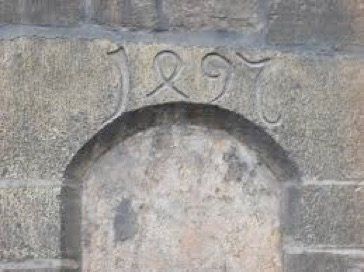Welcome to the oldest house in Geising!
The door stone under which you entered the house
bears the year 1497.
The half eight as four is remarkable.
What's it all about ?
Here is the explanation and thus the confirmation,
how old the house is:
Spelling of numbers from the middle of the 15th to the middle of the 16th century
(Excerpt from, illustration from: Deutsche Gaue, Zeitschrift für Heimatforschung, Vol. IX 1908, p.310f.)
...We believe that we are doing our readers a favor by putting together a series of correct Arabic numerals (Wattenbach). It often happens that you find them written as years on antiquities.
Your decipherment should now facilitate this compilation as well as the following remark:
You notice that the digits almost only mean years from 1450 - 1550. Except in manuscripts, years in Arabic numerals rarely appear in our country.
The years after 1550, on the other hand, are so similar to ours that the key (fig. Left) is not necessary. The first digit, if the year is written out with all 4 digits, can always be interpreted as 1 and the second digit always as 4 or 5. For 4 you always remember the characteristic signs that are not at all like our 4. The 5 is the same as our 5 in the main lines.
Easier than reading the third and fourth digit of the year are 1, 6, 8, 9, 0 and since 4 and 5 already occur, these too. One is often in doubt whether to read 2 or 3: the lower half of 2 mostly strives to the left, that of 3 mostly to the right, as we still write or print it today: 2, 3. For 7, note the spelling ^, this not = 1.
Of course, you can often stand in front of weathered wayside shrines and gravestones for half an hour to decipher the year. One must pay attention to the forms of the monument, whether late Gothic or Renaissance; never be tempted to read 1200 or even 1100, because in these centuries there are no Arabic numerals on monuments; us even only one example from the 14th century. known. Sometimes the first digit is missing, then the year is not 520 but 1520 (see example on fig.); sometimes the first two digits are missing; then one must add 14 or 15 depending on the other observations ...
Here are some examples to practice with
Hohensalzburg Fortress
Johanniskirche Wernigerode
Halberstadt
Hallstatt :







